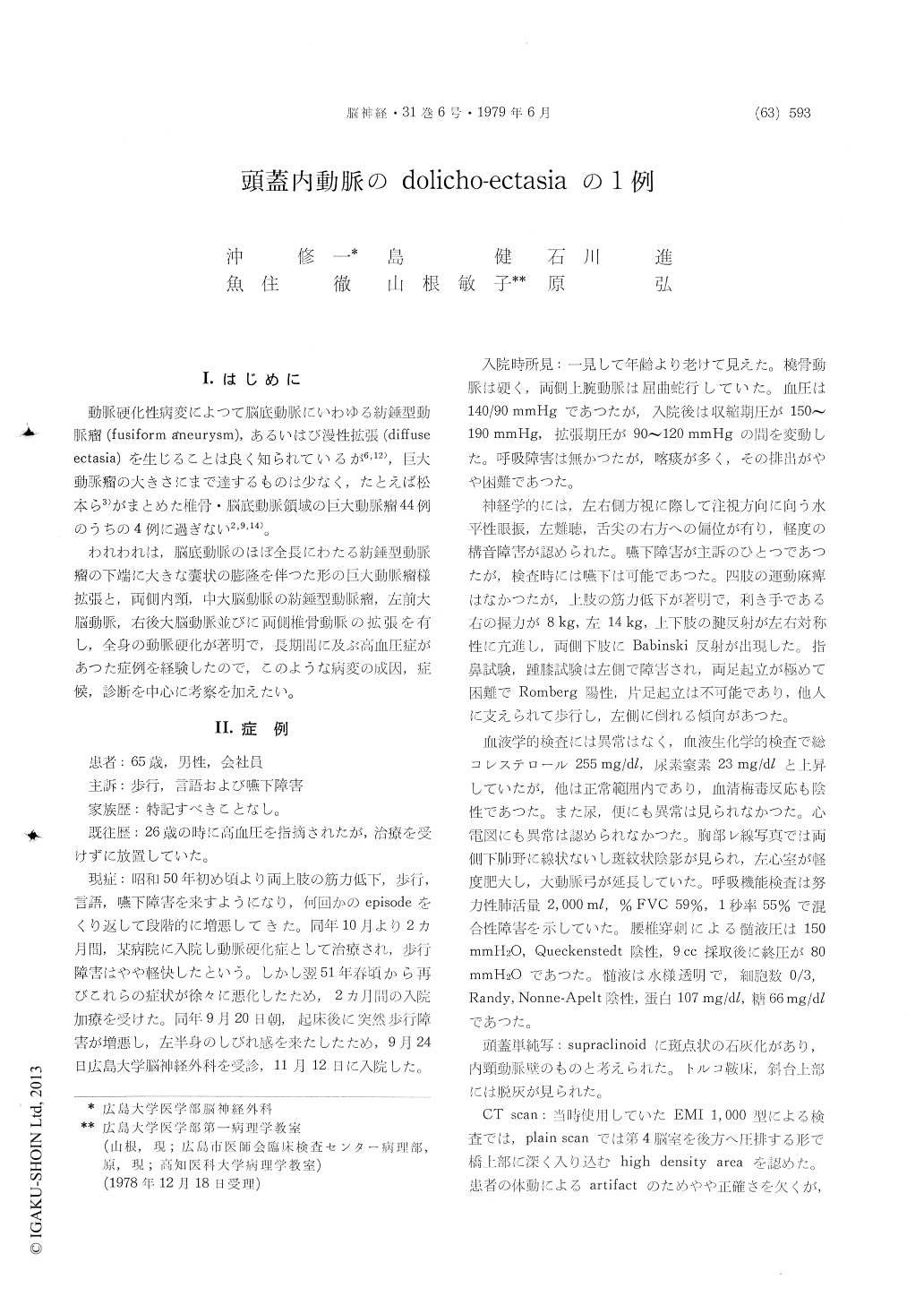Japanese
English
- 有料閲覧
- Abstract 文献概要
- 1ページ目 Look Inside
I.はじめに
動脈硬化性病変によつて脳底動脈にいわゆる紡錘型動脈瘤(fusiform aneurysm),あるいはび漫性拡張(diffuseectasia)を生じることは良く知られているが6,12),巨大動脈瘤の大きさにまで達するものは少なく,たとえば松本ら3)がまとめた椎骨・脳底動脈領域の巨大動脈瘤44例のうちの4例に過ぎない2,9,14)。
われわれは,脳底動脈のほぼ全長にわたる紡鍾型動脈瘤の下端に大きな嚢状の膨隆を伴つた形の巨大動脈瘤様拡張と,両側内頸,中大脳動脈の紡錘型動脈瘤,左前大脳動脈,右後大脳動脈並びに両側椎骨動脈の拡張を有し,全身の動脈硬化が著明で,長期間に及ぶ高血圧症があつた症例を経験したので,このような病変の成因,症候,診断を中心に考察を加えたい。
A fusiform aneurysm or diffuse ectasia due to arteriosclerotic degeneration of the arterial wall is not uncommon in the vertebro-basilar system. How-ever, it is rather rare that this sort of aneurysm of ectasia attains a so-called giant size.
This 65-year-old man was admitted to Hiroshima University Hospital with a 2 years history of dis-turbance of gait, speech and swallowing. At the age of 26 he was found to be hypertensive, but he did not take doctor's advice to undergo medical treatment.
On admission the systemic blood pressure flac-tuated between 150 and 190 mmHg and the diastolic between 90 and 120 mmHg. Neurological exami-nation revealed horizontal nystagmus on lateral gaze, hearing disturbance on the left side, devia-tion of the tongue to the right and dysarthria. Swallowing was slightly difficult. Grasping power was 8 kg on the right and 14 kg on the left. Re-flexes of the four limbs were symmetrically ac-centuated and Babinski sign was observed on both sides. Finger-to-nose test and heel-to-knee test were disturbed on the left. He had difficulty in standing, tended to fall to the left and unable to walk without support.
Total cholesterol in blood was 255 mg/dl and urea nitrogen 23 mg/dl, serologic reactions of syphilis were negative. Left ventricular hypertrophy was shown by chest X-ray examination. The CSF was under normal pressure and had no special changes.
Plain skull X-ray films showed supraclinoid fleck-wise calcification and atrophy of the sellar floor and clivus. On plain CT film a high density area was found in the pontine level, which compressed the 4th ventricle. Enhanced CT scan revealed an unevenly enhanced mass of 3.3 × 4.4 cm in size in the position of the brain stem and high density areas of 1.4 × 3.3cm along the both sphenoid ridges (Fig. 1). RI hot scan was found in the region of the brain stem (Fig. 2). Carotid angiography demonstrated fusiform aneurysms of the bilateral internal carotid and middle cerebral arteries and the dilatation of the left anterior cerebral artery (Fig. 3 a, b). Vertebral angiography showed the dilatation and tortuosity of the basilar, left ver-tebral and right posterior cerebral arteries in A-P views (Fig. 4a). In lateral views the dilated basilar artery formed a dorsally convex arch 2.3 cm distant from the clivus and measured to be a megadolicho-basilar anomaly (Fig. 4b). The patient died of cardiac infarction on the following day.
Autopsy revealed a giant ectasia of the basilar artery and a giant saccular aneurysm at the junc-tion of the vertebral arteries. The brain stem and left cerebellar hemisphere were remarkably com-pressed and deformed by these lesions. There were multiple fusiform aneurysms or ectasias of the other intracranial arteries (Fig. 5). The lumen of the dilated basilar was filled with thrombus except the angiographically demonstrated vascular channel, which was pushed away dorsally on the transvers section (Fig. 6). The advanced sclerotic changes were found in the intracranial and systemic arteries (Fig. 7).
Sacks and Lindenburg reported 34 cases of dolicho-ectatic intracranial arteries including 9 cases under the age of 60 as congenital origin based on their pathological findings and their age of onset. They concluded that dolicho-ectasia occured without arterisoclerosis and the presence of arteriosclerosis was rather coincidental.
Our case showed a giant dolicho-ectasia of basilar artery and ectasia of other intracranial arteries.

Copyright © 1979, Igaku-Shoin Ltd. All rights reserved.


